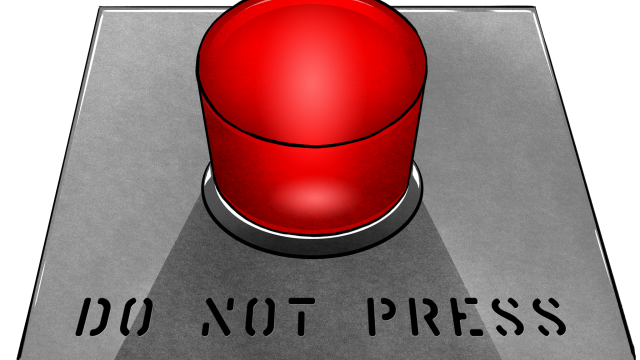Whatever you do, don’t press that button. It’s a trope that’s spanned pop culture for generations — and the real world, too. But where did this Big Red Button come from? And why does sick curiosity compel us to mash it down?
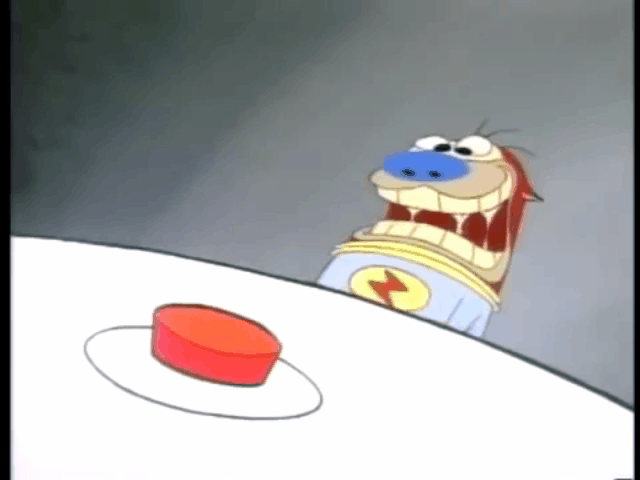
The Cold War Button
During the Cold War, the infamous red button never to be pushed was a metaphor: give into it and the nukes start flying. Of course, that button never actually existed. Indeed, big red buttons are usually used to stop a perilous situation, not start one. The exact origin is hard to pin down, but red buttons started appearing alongside technology that could be considered dangerous and so needed an ABORT function that could be executed simply and quickly.
They’re sometimes called “kill switches.” That is, safety mechanisms that turn a device off in an emergency, and the device can’t be disabled any other way. Like an physical Force Quit. In some cases, it’s an absolute last resort; the only way out in a potentially harrowing crisis.
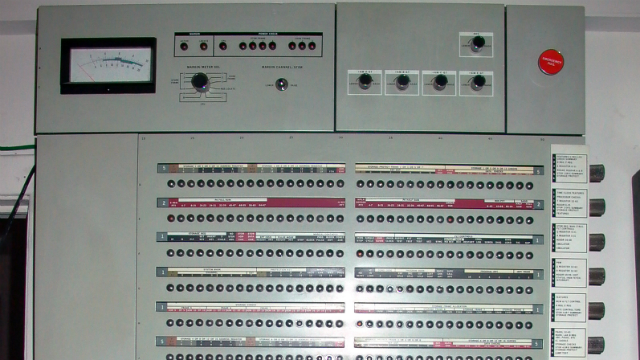
An IBM System/360 Model 64 operator’s console with a Big Red Button “emergency pull” in the upper right. Credit: Wikipedia
Again, the exact genesis of Big Red Buttons in real life is pretty fuzzy. But an early, documented example? IBM’s System/360 Model 65 computer, which shipped in November 1965, was known for its “emergency pull,” a big red button located in the upper righthand corner of the console. It was large, alarmingly crimson, and nice and separated from all the other buttons and switches. According to the computer’s user manual, activating the switch turned off all power on every unit that was part of the system.
The big red button may take the form of an emergency brake on public transit, or car dashboards. It’s the button that switches on the emergency hazard light, and is often fire engine red. In fact the button serve as a fire alarm, in which case it’s often protected by glass to mitigate any passerby compulsions to push it.
Some nuclear power plants have something called “scram switches.” Their function is try to stop a nuclear disaster from happening: They cause cooling rods to plummet into a reactor with — the goal being to halt a nuclear reaction.
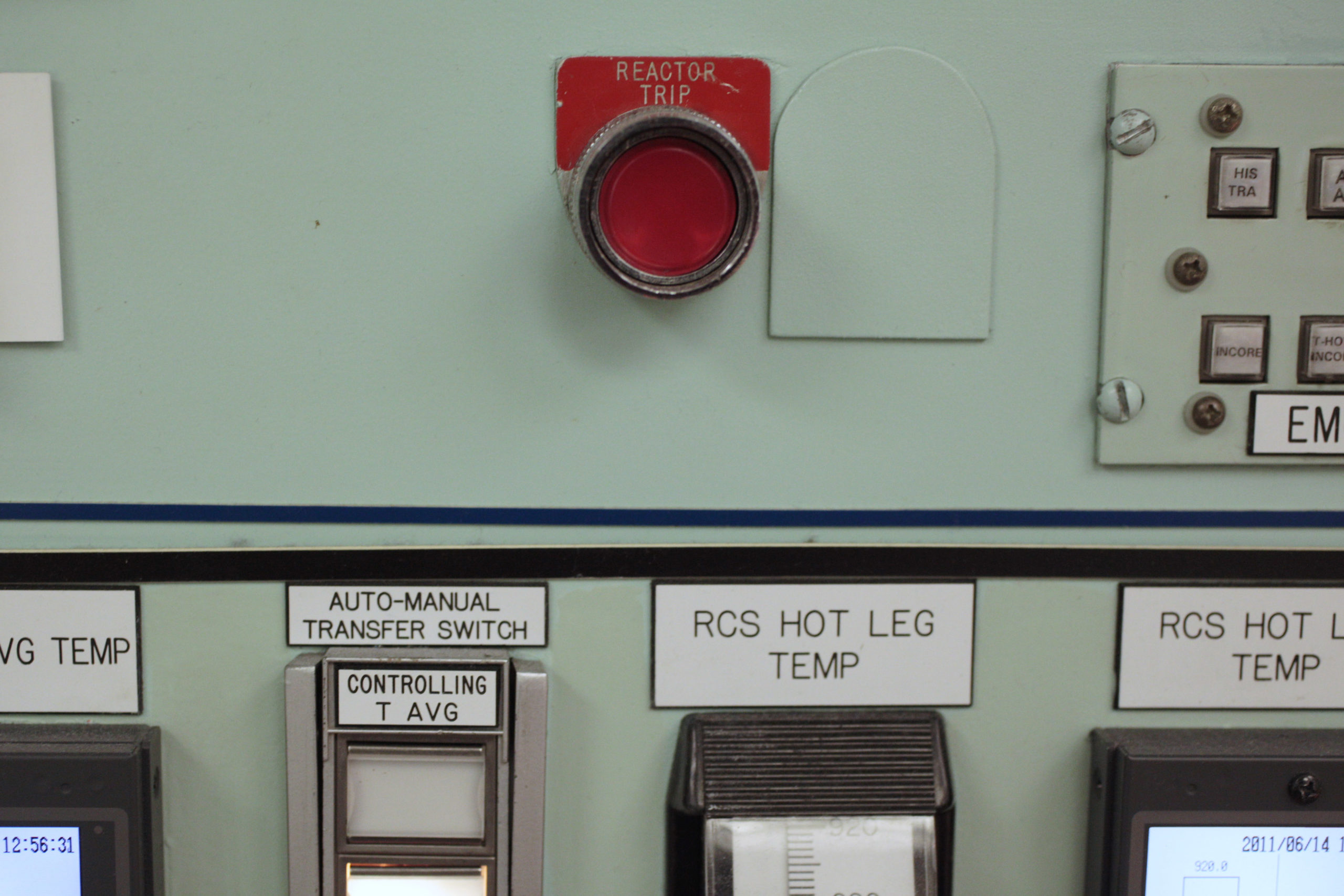
A “reactor trip” button in Florida’s Crystal River Nuclear Plant. Credit: AP
Back in 2009, then-Secretary of State Hillary Clinton jokingly gifted Russia’s then-Foreign Minister Sergey Lavrov a bulbous red “Reset Button” to usher in a new era of American-Russo relations. The joke was lost in translation and bombed. But by then the conspicuous crimson buttons had already seeped into American pop culture.
“Don’t Touch It, You Idiot!”
The big red button trope is up there with the slapstick banana peel and plummeting anvils. Usually one character instructs another to never, under any circumstances, press this button. Lo and behold, what happens? The disobediently curious character presses the red button. Something blows up, usually.
The button is a genre-spanning apparatus that’s tested weak wills and spurred cartoonishly cataclysmic events for decades. TVTropes.com files these buttons under such time-tested cliches as “What Does This Button Do?“, “Plot-Sensitive Button“, and “Don’t Touch It, You Idiot!” We saw them in scores of James Bond movies, where they triggered ejector seats or overloaded nuclear reactors. In Dexter’s Laboratory, hyperactive big sister Dee Dee’s running gag became pressing a red button against Dexter’s commands, which reliably led to disastrous consequences. And in Men in Black, there’s a “little red button” in the agents’ car that K tells J to steer clear of, except for emergencies — and when it’s pressed, their ride transforms into a wall-climbing menace powered by space shuttle-like thrusters. In Spaceballs, Dark Helmet is thrown into a Big Red Button, which initiates the ship’s self-destruction.
It’s hard to pin down its exact genesis, but one particularly early example is a short story that appeared in Playboy in 1970, called “Button, Button“, by legendary sci-fi writer Richard Matheson (I Am Legend, The Shrinking Man). In the original short story, a couple receives a box with a button inside. Every time they press it, and they will receive $50,000. However, someone they don’t know will also die. (Isaac Asimov also wrote a short story called “Button, Button” in 1953, but that plot was completely different.) It went on to inspire a Twilight Zone episode in the 80s, and even inspired The Box, a clunky 2009 Cameron Diaz thriller.
Do they press it? If so, how many times do they press it? It was one of the earliest examples of buttons in pop culture being used to tap into characters’ dark sides, or at least, a curiosity that gets the better of them.
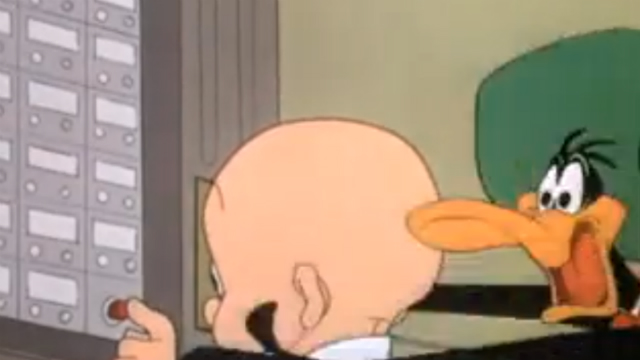
Daffy warns Elmer to “don’t ever push the ‘wed’ one.” (It ends up being a tidal wave safety mechanism that catapults the house into the sky.) Picture: Dailymotion
The Psychology of Button Mashers
If there’s a big red button in front of us, it’s too tantalising not to touch, especially if we’re told not to.
“We willingly push any and every button because we hope that it provides a squirt of dopamine for pleasure,” says Larry Rosen. He’s a psychologist and professor at California State University and has written several books about psychology and technology. “Or at least, [it] reduces the cortisol that is making us anxious — until we see what pressing it means.”
In general, the more we’re told not to do something, the more we want to do that thing. In pop culture, it’s tied to the Big Red Button in beyond, with such tropes as “Forbidden Fruit,” “Curiosity Killed the Cast,” and “Do Not Do This Cool Thing.” In psychology, this can be explained by reactance theory, which says that if our freedom of choice is threatened, we feel compelled to protect that freedom, making us want the taboo thing even more. It’s been used to study the relatively high drinking age in America, which has been found to promote illegal, underage drinking in college students.
As far as buttons go, buttons equal power. Press one, and something always happens. In the real world, rarely is that “something” negative. Often, it’s summoning something, or someone. The call button on an aeroplane, or a doorbell. We want to press buttons because we think it will help us achieve or obtain something. And when we’re told not to press a button, some people find it hard to resist the urge. It’s human nature.
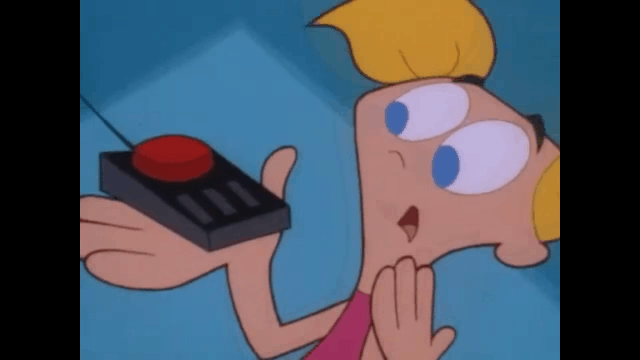
Dee Dee GIF via YouTube: “What does this button do?”
Back in April, Reddit launched an April Fool’s joke-turned-social experiment simply called “The Button.” It involved a timer counting back from 60 to zero. However, if another person somewhere out there on the interwebs pressed the button, the timer reset. It was kind of a case study in delayed gratification, since users tried to keep the timer running so the experiment could be successful. But someone in the world was always ready to click, which screwed everything up. At last, in early June, it reached zero — even though it took more than months and one million clicks.
Big red button psychology has been gamified in other ways too: There are other “games” online that taunt you to press (or not press) the red button. One of them is an Android app that’s been rated over 5500 times.
But in today’s social media-drenched landscape, the big, knobby red buttons of kill switches and doomsday devices have been replaced with a different button — digital ones on touch screens and websites. And at least on Facebook, the button is still red. It’s that notification alert that lets you know someone’s messaged you, liked a photo, or has delivered to you some form of social affirmation that you always just have to check, real quick!
“We react to a ‘button’ showing we have a text or a notification viscerally, and find ourselves acting a bit like Pavlov’s dogs and rushing to react to that button,” says Larry Rosen. Whether it’s a physical button or a digital one, if it’s in front of us, we feel a need to push it — because in doing so will bring some kind of satisfaction. Or at least we think it will.
Illustration: Jim Cooke
